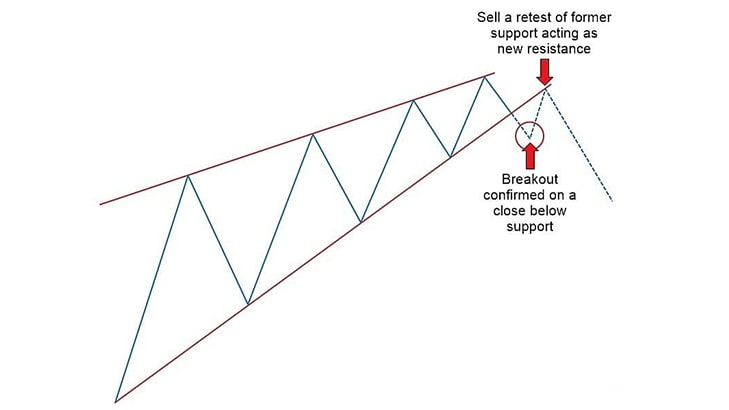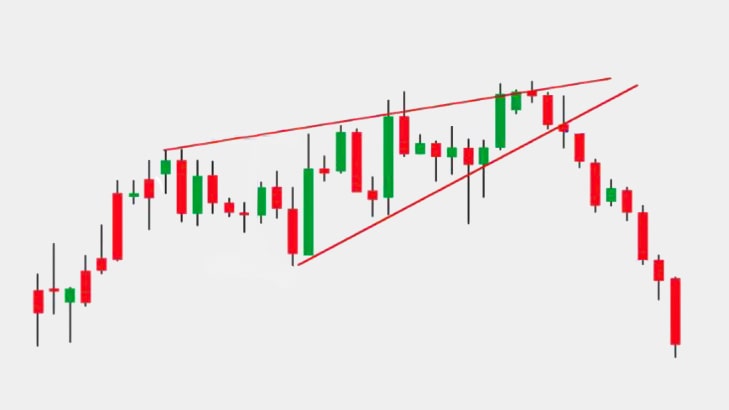
A rising wedge chart pattern is a technical analysis pattern that occurs in financial markets, particularly in stocks, forex, and commodities. It’s characterized by converging trendlines that slope upwards, forming a shape resembling a wedge or triangle. Here’s a breakdown of its key features and implications:
Formation: A rising wedge pattern forms when the price of an asset consolidates between two ascending trendlines. The upper trendline connects the swing highs, while the lower trendline connects the swing lows. Both trendlines slope upwards, with the upper trendline usually steeper than the lower one.
Bearish Reversal Pattern: Despite the term “rising,” this pattern is actually considered bearish. It suggests that while the price is making higher highs and higher lows, the upward momentum is weakening. This can be an indication of potential exhaustion in the bullish trend.
Volume Analysis: Volume analysis can be crucial in confirming the validity of the pattern. Typically, volume tends to decline as the pattern progresses, signaling decreasing enthusiasm from buyers.
Breakdown: The confirmation of a rising wedge pattern occurs when the price breaks below the lower trendline. This breakdown is often accompanied by increased volume, further validating the pattern. Traders often look for a decisive close below the lower trendline to confirm the bearish signal.
Price Target: The price target for a rising wedge pattern is usually measured by the height of the back of the wedge (the left side) and projected downwards from the point of breakout. This gives traders an estimate of how far the price might decline after the breakdown.
False Breakouts: Like any technical pattern, false breakouts can occur where the price briefly moves below the lower trendline but then quickly reverses back into the pattern. Traders should wait for confirmation before taking action.
Pattern Failure: In some cases, the rising wedge pattern may not lead to a significant price decline. If the price breaks out above the upper trendline instead of below the lower one, it could signal a failed pattern. This could indicate a continuation of the previous trend or a period of consolidation.
As with all technical analysis tools, it’s essential to use rising wedge patterns in conjunction with other indicators and analysis techniques for better accuracy and confirmation.

राइजिंग वेज चार्ट पैटर्न एक तकनीकी विश्लेषण पैटर्न है जो वित्तीय बाजारों में होता है, खासकर स्टॉक, फॉरेक्स और कमोडिटी में। इसकी विशेषता ट्रेंडलाइनों को एकत्रित करना है जो ऊपर की ओर झुकती हैं, जिससे एक पच्चर या त्रिकोण जैसी आकृति बनती है। यहां इसकी प्रमुख विशेषताओं और निहितार्थों का विवरण दिया गया है:
- गठन: एक उभरता हुआ पच्चर पैटर्न तब बनता है जब किसी परिसंपत्ति की कीमत दो आरोही प्रवृत्ति रेखाओं के बीच समेकित होती है। ऊपरी ट्रेंडलाइन स्विंग हाई को जोड़ती है, जबकि निचली ट्रेंडलाइन स्विंग लो को जोड़ती है। दोनों ट्रेंडलाइन ऊपर की ओर झुकती हैं, ऊपरी ट्रेंडलाइन आमतौर पर निचली ट्रेंडलाइन की तुलना में अधिक तीव्र होती है।
- मंदी उत्क्रमण पैटर्न: “बढ़ते” शब्द के बावजूद, इस पैटर्न को वास्तव में मंदी माना जाता है। इससे पता चलता है कि जहां कीमत ऊंचे ऊंचे और ऊंचे निचले स्तर पर पहुंच रही है, वहीं ऊपर की ओर बढ़ने की गति कमजोर हो रही है। यह तेजी के रुझान में संभावित थकावट का संकेत हो सकता है।
- वॉल्यूम विश्लेषण: पैटर्न की वैधता की पुष्टि करने में वॉल्यूम विश्लेषण महत्वपूर्ण हो सकता है। आमतौर पर, जैसे-जैसे पैटर्न आगे बढ़ता है, वॉल्यूम में गिरावट आती है, जो खरीदारों के उत्साह में कमी का संकेत है।
- ब्रेकडाउन: बढ़ते वेज पैटर्न की पुष्टि तब होती है जब कीमत निचली ट्रेंडलाइन से नीचे टूट जाती है। यह टूटना अक्सर बढ़ी हुई मात्रा के साथ होता है, जो पैटर्न को और अधिक मान्य करता है। मंदी के संकेत की पुष्टि के लिए व्यापारी अक्सर निचली ट्रेंडलाइन के नीचे एक निर्णायक समापन की तलाश करते हैं।
- मूल्य लक्ष्य: बढ़ते वेज पैटर्न के लिए मूल्य लक्ष्य आमतौर पर वेज के पीछे (बाईं ओर) की ऊंचाई से मापा जाता है और ब्रेकआउट के बिंदु से नीचे की ओर प्रक्षेपित किया जाता है। इससे व्यापारियों को यह अनुमान मिलता है कि ब्रेकडाउन के बाद कीमत में कितनी गिरावट आ सकती है।
- गलत ब्रेकआउट: किसी भी तकनीकी पैटर्न की तरह, गलत ब्रेकआउट हो सकता है जहां कीमत थोड़ी देर के लिए निचली प्रवृत्ति रेखा से नीचे चली जाती है लेकिन फिर जल्दी ही पैटर्न में वापस आ जाती है। व्यापारियों को कार्रवाई करने से पहले पुष्टि की प्रतीक्षा करनी चाहिए।
- पैटर्न विफलता: कुछ मामलों में, बढ़ते वेज पैटर्न से महत्वपूर्ण कीमत में गिरावट नहीं हो सकती है। यदि कीमत निचली ट्रेंडलाइन के बजाय ऊपरी ट्रेंडलाइन के ऊपर टूटती है, तो यह एक विफल पैटर्न का संकेत दे सकता है। यह पिछली प्रवृत्ति की निरंतरता या समेकन की अवधि का संकेत दे सकता है।
सभी तकनीकी विश्लेषण उपकरणों की तरह, बेहतर सटीकता और पुष्टि के लिए अन्य संकेतकों और विश्लेषण तकनीकों के साथ बढ़ते वेज पैटर्न का उपयोग करना आवश्यक है।







